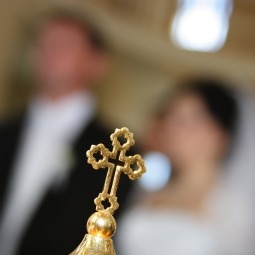Holy See Reforms Its Communications Agency
After an 18-month study and seeking the advice of media experts on reforming the Vatican’s media operation, three Vatican appointments shortly before Christmas signaled the beginning of those reforms.
The Holy See announced on Dec. 21 that, starting Feb. 1, St. Louis native and former Register and Fox News correspondent Greg Burke will become the new vice director of the Holy See Press Office, replacing San Marino Passionist Father Ciro Benedettini, who served in the role for 20 years.
The position has until now involved assisting the press office director in staging press conferences, overseeing administration and disseminating information, as well as sometimes representing the Holy See in Jesuit Father Federico Lombardi’s absence.
Since June 2012, Burke served as senior communications adviser at the Secretariat of State, a largely behind-the-scenes role, in which he was responsible for the Holy See’s media strategy and helping to improve the Pope’s public image.
Initially hired during the pontificate of Benedict XVI, after a series of media gaffes, Burke has tried to make the Vatican more media sensitive and aware. He helped launch a papal Twitter account in December 2012, but his main role has been “putting out fires” and preventing potentially damaging public-relations mistakes from reaching the media.
In recent weeks, Burke, an Opus Dei numerary, had been rumored to be a potential successor to Vatican spokesman Father Lombardi. But it appears Father Lombardi may remain in the role for the foreseeable future, possibly until he reaches the usual Vatican retirement age of 75 in 18 months’ time. He may then make way for Burke, who, by then, will have gained valuable experience shadowing Father Lombardi in the role.
The appointment of Burke, 55, leaves Basilian Father Thomas Rosica’s position in some doubt. The U.S. priest and founder of Salt and Light Television has been serving as English-language attaché at the Holy See Press Office for the past few years, effectively acting as Father Lombardi’s English-language deputy.
Burke’s appointment follows that of Msgr. Paul Tighe, who Pope Francis appointed Dec. 19 as adjunct secretary at the Pontifical Council for Culture and elevated to bishop. Since 2008, Bishop-elect Tighe has served as secretary at the Pontifical Council for Social Communications.
During that time, the 57-year-old Irish monsignor played a significant role as secretary to the Committee for Vatican Media, a special commission headed by Lord Christopher Patten of Barnes to recommend possibilities for Vatican communications reform. At the conclusion of the committee’s work, Bishop-designate Tighe presented its conclusions to Pope Francis and the “C9” council of cardinals.
At the Pontifical Council for Culture, Bishop-elect Tighe may continue to work in media outreach to promote communications reform, in harmony with the new Secretariat for Communications that Francis established through an apostolic letter published in the summer.
That letter stated that the Pontifical Council for Social Communications would be incorporated into the Secretariat for Communications. Also becoming part of the new department is the Holy See Press Office, Vatican Internet Service, Vatican Radio, Vatican Television Center (CTV), L’Osservatore Romano, Vatican Typography, Photograph Service and the Vatican Publishing House (Libreria Editrice Vaticana).
Msgr. Dario Viganò, until now director of CTV, is heading the secretariat. The Vatican also announced Dec. 21 he is to be replaced as director by Italian layman Stefano D’Agosotini, a longtime CTV official.
In a Dec. 15 interview with Vatican Radio, Msgr. Viganò said, “In January, we will begin to understand what we must do, what are our strengths, what are the greater values we can continue to convey or we can also emphasize. And from there, we will see what the path will be, a path that must be shared in some way.”
He added that decisions will have to be taken, but always consistent with “apostolic service” and “taking into account the value and excellence that we have.”
Msgr. Viganò said the Pope gives “no strategic importance” to communication, but sees it as important in the sense of creating communion with others through “being attentive to the person.”
The Italian priest recalled how, when getting ready to give a video message, the Pope greets every person involved in the production. “This is a way of being close to the people, of being in communion with the person. These are performative acts of communication,” he said.
The Pope, he added, “continually returns to the essentials, not baroquisms,” and “from this point of view, one is also able to listen.” By stressing he is a sinner like everyone else, people can identify with him, sense his solidarity with them and be bearers of hope and charity like him, Msgr. Viganò said.
Also important are the Pope’s gestures, he continued, adding that his body “speaks much; it’s a body that writes history; it’s a body like Jeremiah in the Bible.” The Pope gave “many important speeches” in Kenya, Uganda and Central African Republic, “but the important thing was his presence,” he said, especially in war-torn Central African Republic.
“A religious sister from Bangui wrote to me saying: ‘It’s an extraordinary thing: For the first time, you see Muslims entering places they hadn’t entered before, without weapons; Muslims who give lifts to Christians in motorcycle taxis; Christians who give lifts to Muslims, and it is an extraordinary thing! There is a contagion of the fact that there is a possibility of hope and peace, which until then had gone.’”
- Keywords:
- Jan. 10-23, 2016


















